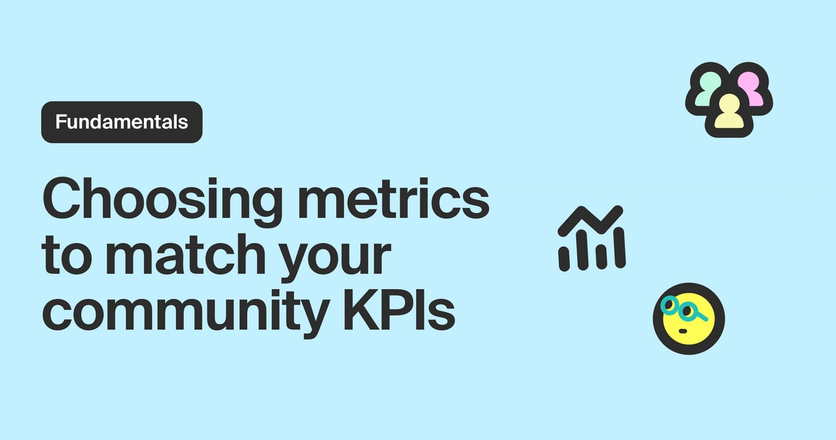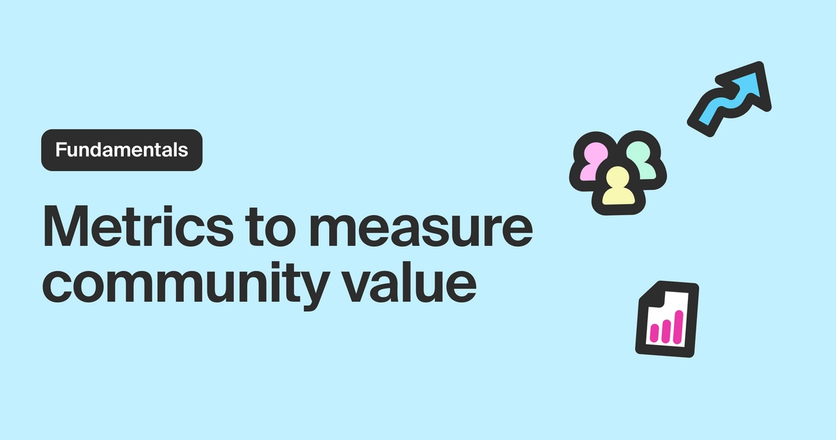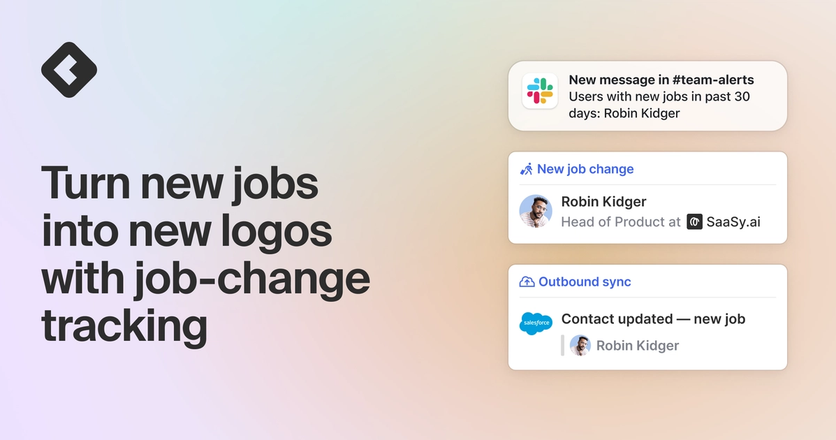9 min read
The most successful organizations use data to inform their business decisions. You can take a similar approach to growing your user community by using metrics and the practice of community analytics.
Read on to learn more about community analytics, why they’re essential for building a successful user community, and a checklist of important metrics to get you started.
What are community analytics?
Community analytics are the insights you get from using data to understand, measure, and improve the health and effectiveness of a community. These insights are come from:
- Tracking key community metrics such as engagement, retention, and growth
- Analyzing these metric to better understand and anticipate the behaviors and needs of members
- Connecting community activity to business impact
Community analytics can also refer to the practice or discipline of gathering these insights, often led by a community operations manager with tools from their community tech stack.
Community metrics vs. community analytics: what’s the difference?
Let’s clarify the difference between community metrics and community analytics. Metrics are simply measurements or quantified values from your data. These metrics can be analyzed to derive community analytics—or insights to inform decision-making.
Simply put, community metrics are the data points you collect and community analytics are the insights extracted from them. The two are related, but it’s important to understand the distinction.
For example, collecting metrics on membership gives you a total number of community members. Adding analytics will help you understand what percentage of that number are active members, contributors, or even champions.
While community metrics are a great starting point for understanding your community, the depth of information provided by a community analytics approach can help better inform the actions you take to enhance your members’ experience in the community and its impact on your business.
Why do you need community analytics?
Community analytics give you the actionable information you need to best serve and grow your community.
They help community teams identify and analyze trends and patterns in member behavior and activity. Because they bring together data points from across the community, these analytics also give you the information you need to understand the impact of initiatives and programs on key metrics like engagement and retention.
Community analytics use cases
At the user level, community analytics can help you understand who your most important members are by identifying key contributors and advocates based on their activity and influence. This allows you to find and cultivate product champions to both recognize these members and encourage them to keep contributing, which benefits the whole community.
For go-to-market leaders, community analytics can bring together community and firmographic data to do things like source and qualify new leads and improve account-based marketing performance. By connecting community data to revenue, you can also see how community engagement and activity directly impacts business results.
In this way, community analytics both support you as you scale your community as well as play a vital role in intelligent community growth.
Important metrics for community analytics
Growing a healthy and robust community around your product or practice starts with a solid understanding of your community metrics. Once you’ve got a handle on this data, you can use community analytics to gain deeper insights and take action.
You’ll want to look at the following types of metrics and analytics to grow and maintain a thriving community (and business):
- Membership
- Engagement
- Responsiveness
- Business impact
Membership
Avoid focusing solely on membership growth at the expense of positive community engagement. A small community that actively engages is healthier and more valuable than a large community that doesn't.
Community analytics can give you the number of community members and the mix of member types. Are they influencers with broad networks and reach? Or are they contributors who spend time teaching, answering, and helping other community members? With a community analytics approach, you can find your champions based on how they engage and build programs to better support them.
Engagement
Engagement metrics should be more than just looking at the number of posts and likes.
Metrics can include:
- How often members participate in community conversations, events, and programs across all channels
- How frequently members interact with each other
- What topics are most interesting and engaging to members
Responsiveness
Responsiveness shows you how fast and often community members are responded to when they post. It’s a key measure that directly impacts satisfaction, but it’s difficult to unlock without community analytics.
Aggregate metrics from:
- The percentage of posts with at least one reply
- Average response time
- Percentage of responses by community members vs. team members
This will give you insight into:
- Which community channels are most active and effective
- If your community members are receiving timely responses
- Whether your community is reaching the self-sustaining point where the majority of answers are coming from other community members
Adjusting how you engage with your members using these insights will keep your members feeling happy and involved with the community.
Business impact
Tying community activity to company goals is often the most effective way to demonstrate the power and impact of a user community.
On the most basic level, community members provide real user feedback and can drive decisions about product development pipelines and investment initiatives.
Analytics can also connect community activity to concrete company value.
Collect metrics on:
- Product usage
- Feature feedback and bug reports
- Engagement with support and education resources shared via community channels
- Amount of support cases
- Revenue
This will give you insight into:
- Top issues or feature requests for a product
- The effectiveness of community member peer-to-peer knowledge sharing in reducing internal support needed
- Community-attributed revenue or revenue from organizations that appeared in the community before becoming an opportunity in your CRM
- Community impact on time to close and customer retention
While each community and the company behind it will have different goals, these sample insights should help you start to understand how community analytics will allow you to more effectively articulate the value of community to the business.
Checklist: important metrics for community analytics
Use this checklist of community metrics to effectively demonstrate your community’s impact.
Membership
- The number of members in your community (this should generally grow over time, but not at the expense of other metrics)
- A mix of members by type, such as influencers, contributors, and those who’ve completed a certification program (if you offer one)
Engagement
- Total volume of platform activities, such as posts, replies, pull requests, and event attendance
- Top trending discussion topics, such as feature requests, bugs, and product appreciation
- Percentage of members who are actively contributing back to your community by answering questions, sharing content, and engaging with others
- Percentage of members who are product champions
- Frequency and geographic distribution of member-hosted events
Responsiveness
- Response rate percentage (number of posts, conversations, etc. with at least one reply)
- Median response time
- Percentage of responses by community members versus team members
Business Impact
- Product usage or spend
- Reach and effectiveness of product education
- Number of customer support cases
You can also read how organizations such as Asana, dbt Labs, Moov, and Temporal measure community success and drive business impact.
What are some challenges with community analytics?
Major challenges for community managers may include the following:
Scale
Growth is the key objective for most community leaders, but the community could scale to a point where the influx of data is too much to properly organize and analyze using manual methods like spreadsheets or underpowered tools.
Multiple platforms
Your team-managed communities will likely be spread across more than one channel (such as Slack, GitHub, and Discourse), and your members will have their own preferred places where they like to engage (including Twitter, LinkedIn, and Reddit). This makes it difficult to both get a comprehensive view of what’s happening across your entire community as well as how each individual member is engaging across channels.
Collecting and combining multiple data types
Customer data (such as organization size, current deal stage, or opportunity amount) and product data (which may include feature use or last active date) can be difficult to measure without a dedicated data team or tool.
Member identity resolution and attribution
You need to be able to see and analyze member engagement across sources (including in your product) and attribute that activity to progress toward becoming a customer. Managing the data behind each of these interactions and being able to connect it to an individual community member confidently is an often-seen barrier.
Reporting
Finding a way to deliver metrics and analytics so they can be appropriately interpreted is a common challenge. Community leaders will likely have to generate multiple reports depending on the audience (sales, product, and customer support teams might all receive different business impact metric reports highlighting what’s relevant to their department).
An intelligent community growth platform can help community teams tackle these challenges with the help of AI and automation. These platforms bring together data across all community channels for an easy-to-navigate and holistic view of your members and their activity, even as your community grows. Prebuilt and customizable reports from this data allow you to track and take action on key metrics to achieve your community growth goals.
Common Room’s approach to community analytics
Common Room is the leading intelligent community growth platform. It brings together community engagement, product usage, and customer data into a single place, and uses AI to surface actionable insights that enable community leaders to discover what’s most important, nurture members, collaborate more effectively, and measure outcomes.
Community teams use Common Room to track and manage key community metrics, such as overall membership and engagement, and to get a unified view of each member across all community channels. The platform will also surface insights and trends from across the community, which are essential to understanding community health indicators that tell you how members are engaging, what they’re saying, and how they’re feeling.
Additionally, with community analytics and intelligent insights from Common Room, you can understand the community's impact on your business and better enable community-led growth.
Ready to intelligently engage and grow your community? Try Common Room for free or request a demo. If you’re interested in building out more advanced and actionable community analytics, check out Prove community ROI: Scale your community's impact and empower the business. And to chat community growth with community and DevRel pros like you, join us in the Uncommon Community Slack.
We think you'd like these

What your community metrics and analytics are telling you
Feb 9th, 2023·13min readCommunity
Assembling a strategy for community-led growth
Jan 11th, 2023·12min readCommunity
Using metrics to understand community growth and business impact
Dec 8th, 2022·10min readCommunity
Turn new jobs into new logos with job-change tracking
Apr 25th, 2024·6min readProduct
